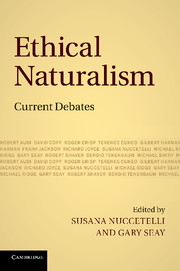Book contents
- Frontmatter
- Contents
- Contributors
- Introduction
- Chapter 1 Naturalism in moral philosophy
- Chapter 2 Normativity and reasons: five arguments from Parfit against normative naturalism
- Chapter 3 Naturalism: feel the width
- Chapter 4 On ethical naturalism and the philosophy of language
- Chapter 5 Metaethical pluralism: how both moral naturalism and moral skepticism may be permissible positions
- Chapter 6 Moral naturalism and categorical reasons
- Chapter 7 Does analytical moral naturalism rest on a mistake?
- Chapter 8 Supervenience and the nature of normativity
- Chapter 9 Can normativity be naturalized?
- Chapter 10 Ethical non-naturalism and experimental philosophy
- Chapter 11 Externalism, motivation, and moral knowledge
- Chapter 12 Naturalism, absolutism, relativism
- Bibliography
- Index
Chapter 1 - Naturalism in moral philosophy
Published online by Cambridge University Press: 05 January 2012
- Frontmatter
- Contents
- Contributors
- Introduction
- Chapter 1 Naturalism in moral philosophy
- Chapter 2 Normativity and reasons: five arguments from Parfit against normative naturalism
- Chapter 3 Naturalism: feel the width
- Chapter 4 On ethical naturalism and the philosophy of language
- Chapter 5 Metaethical pluralism: how both moral naturalism and moral skepticism may be permissible positions
- Chapter 6 Moral naturalism and categorical reasons
- Chapter 7 Does analytical moral naturalism rest on a mistake?
- Chapter 8 Supervenience and the nature of normativity
- Chapter 9 Can normativity be naturalized?
- Chapter 10 Ethical non-naturalism and experimental philosophy
- Chapter 11 Externalism, motivation, and moral knowledge
- Chapter 12 Naturalism, absolutism, relativism
- Bibliography
- Index
Summary
Narrow and wide conceptions of philosophy and philosophical method
Naturalism in philosophy is a special case of a more general conception of philosophy. In this conception there is no special philosophical method and no special philosophical subject matter.
Consider some of the ways in which philosophy interacts with and is continuous with other disciplines.
Aesthetics is obviously pursued in philosophy departments and in departments of literature, music and art. Monro Beardsley, who wrote the most important survey of aesthetics in the twentieth century, was one of the authors of an important statement of a central aspect of the “New Criticism.”
More recently, Richard Wollheim (who may have invented the expression “minimal art”) and Arthur Danto have had a significant influence on art theory and criticism. They themselves have been important critics. Alexander Nehamas is another important contemporary example.
Anthropology. Anthropologists are often involved with philosophy and philosophers have sometimes acted as anthropologists to study the moralities of one or another culture. Richard Brandt lived with the Hopi in order to study their ethics. John Ladd lived with the Navaho in order to study their ethics. The anthropologist Dan Sperber is the same person as the philosopher Dan Sperber.
Keywords
- Type
- Chapter
- Information
- Ethical NaturalismCurrent Debates, pp. 8 - 23Publisher: Cambridge University PressPrint publication year: 2011
- 1
- Cited by



